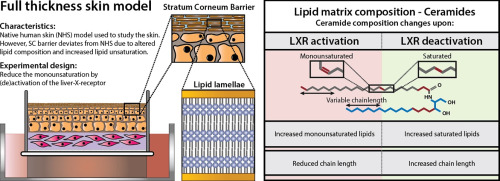当前位置:
X-MOL 学术
›
BBA Mol. Cell Biol. Lipids
›
论文详情
Our official English website, www.x-mol.net, welcomes your
feedback! (Note: you will need to create a separate account there.)
The effects of LXR agonist T0901317 and LXR antagonist GSK2033 on morphogenesis and lipid properties in full thickness skin models.
Biochimica et Biophysica Acta (BBA) - Molecular and Cell Biology of Lipids ( IF 3.9 ) Pub Date : 2019-10-31 , DOI: 10.1016/j.bbalip.2019.158546 Richard W J Helder 1 , Walter A Boiten 1 , Rianne van Dijk 1 , Gerrit S Gooris 1 , Abdoelwaheb El Ghalbzouri 2 , Joke A Bouwstra 1
Biochimica et Biophysica Acta (BBA) - Molecular and Cell Biology of Lipids ( IF 3.9 ) Pub Date : 2019-10-31 , DOI: 10.1016/j.bbalip.2019.158546 Richard W J Helder 1 , Walter A Boiten 1 , Rianne van Dijk 1 , Gerrit S Gooris 1 , Abdoelwaheb El Ghalbzouri 2 , Joke A Bouwstra 1
Affiliation

|
Full thickness models (FTMs) are 3D-cultured human skin models that mimic many aspects of native human skin (NHS). However, their stratum corneum (SC) lipid composition differs from NHS causing a reduced skin barrier. The most pronounced differences in lipid composition are a reduction in lipid chain length and increased monounsaturated lipids. The liver-X-receptor (LXR) activates the monounsaturated lipid synthesis via stearoyl-CoA desaturase-1 (SCD-1). Therefore, the aim was to improve the SC lipid synthesis of FTMs by LXR deactivation. This was achieved by supplementing culture medium with LXR antagonist GSK2033. LXR agonist T0901317 was added for comparison. Subsequently, epidermal morphogenesis, lipid composition, lipid organization and the barrier functionality of these FTMs were assessed. We demonstrate that LXR deactivation resulted in a lipid composition with increased overall chain lengths and reduced levels of monounsaturation, whereas LXR activation increased the amount of monounsaturated lipids and led to a reduction in the overall chain length. However, these changes did not affect the barrier functionality. In conclusion, LXR deactivation led to the development of FTMs with improved lipid properties, which mimic the lipid composition of NHS more closely. These novel findings may contribute to design interventions to normalize SC lipid composition of atopic dermatitis patients.
中文翻译:

LXR 激动剂 T0901317 和 LXR 拮抗剂 GSK2033 对全层皮肤模型中形态发生和脂质特性的影响。
全厚度模型 (FTM) 是 3D 培养的人体皮肤模型,可模拟原生人体皮肤 (NHS) 的许多方面。然而,它们的角质层 (SC) 脂质成分与 NHS 不同,导致皮肤屏障减少。脂质组成最显着的差异是脂质链长度的减少和单不饱和脂质的增加。肝 X 受体 (LXR) 通过硬脂酰辅酶 A 去饱和酶 1 (SCD-1) 激活单不饱和脂质合成。因此,目的是通过 LXR 失活来改善 FTM 的 SC 脂质合成。这是通过用 LXR 拮抗剂 GSK2033 补充培养基来实现的。添加 LXR 激动剂 T0901317 用于比较。随后,评估了这些 FTM 的表皮形态发生、脂质组成、脂质组织和屏障功能。我们证明 LXR 失活导致脂质组合物总链长增加和单不饱和水平降低,而 LXR 活化增加单不饱和脂质的量并导致总链长减少。但是,这些更改并未影响屏障功能。总之,LXR 失活导致了具有改进脂质特性的 FTM 的发展,它更接近地模拟了 NHS 的脂质组成。这些新发现可能有助于设计干预措施以使特应性皮炎患者的 SC 脂质成分正常化。这些更改并未影响屏障功能。总之,LXR 失活导致了具有改进脂质特性的 FTM 的发展,它更接近地模拟了 NHS 的脂质组成。这些新发现可能有助于设计干预措施以使特应性皮炎患者的 SC 脂质成分正常化。这些更改并未影响屏障功能。总之,LXR 失活导致了具有改进脂质特性的 FTM 的发展,它更接近地模拟了 NHS 的脂质组成。这些新发现可能有助于设计干预措施以使特应性皮炎患者的 SC 脂质成分正常化。
更新日期:2019-10-31
中文翻译:

LXR 激动剂 T0901317 和 LXR 拮抗剂 GSK2033 对全层皮肤模型中形态发生和脂质特性的影响。
全厚度模型 (FTM) 是 3D 培养的人体皮肤模型,可模拟原生人体皮肤 (NHS) 的许多方面。然而,它们的角质层 (SC) 脂质成分与 NHS 不同,导致皮肤屏障减少。脂质组成最显着的差异是脂质链长度的减少和单不饱和脂质的增加。肝 X 受体 (LXR) 通过硬脂酰辅酶 A 去饱和酶 1 (SCD-1) 激活单不饱和脂质合成。因此,目的是通过 LXR 失活来改善 FTM 的 SC 脂质合成。这是通过用 LXR 拮抗剂 GSK2033 补充培养基来实现的。添加 LXR 激动剂 T0901317 用于比较。随后,评估了这些 FTM 的表皮形态发生、脂质组成、脂质组织和屏障功能。我们证明 LXR 失活导致脂质组合物总链长增加和单不饱和水平降低,而 LXR 活化增加单不饱和脂质的量并导致总链长减少。但是,这些更改并未影响屏障功能。总之,LXR 失活导致了具有改进脂质特性的 FTM 的发展,它更接近地模拟了 NHS 的脂质组成。这些新发现可能有助于设计干预措施以使特应性皮炎患者的 SC 脂质成分正常化。这些更改并未影响屏障功能。总之,LXR 失活导致了具有改进脂质特性的 FTM 的发展,它更接近地模拟了 NHS 的脂质组成。这些新发现可能有助于设计干预措施以使特应性皮炎患者的 SC 脂质成分正常化。这些更改并未影响屏障功能。总之,LXR 失活导致了具有改进脂质特性的 FTM 的发展,它更接近地模拟了 NHS 的脂质组成。这些新发现可能有助于设计干预措施以使特应性皮炎患者的 SC 脂质成分正常化。











































 京公网安备 11010802027423号
京公网安备 11010802027423号